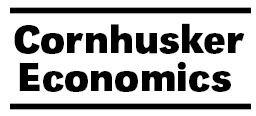Agricultural Economics, Department of

Cornhusker Economics
Date of this Version
6-3-2020
Document Type
Newsletter Issue
Citation
Cornhusker Economics, June 3, 2020
agecon.unl.edu/cornhuskereconomics
Abstract
Government and industry responses to COVID-19 cases have created a variety of unique situations in the agriculture industry. "Stay-at-home" orders forced consumers to be homebound, increasing the demand for food in grocery stores while reducing the need for food in restaurants. These caused a series of rapidly changing supply and demand conditions along the livestock supply chain. Meat destined for restaurants need to be repacked and reprocessed to make it compatible to sell in grocery stores. Meat packing plants continued to try to process harvest-ready animals, but a growing number of positive cases among plant workers forced idling, reduced plant utilizations, and - in some cases - resulted in closures. This created a temporary supply surplus situation for livestock producers while creating a meat shortage for retailers. Since price reflects scarcity in a market system, livestock crash prices dropped and wholesale cut-out prices rose. The cumulative effect was livestock producers selling livestock far below breakeven prices.


Comments
Copyright 2020 University of Nebraska.